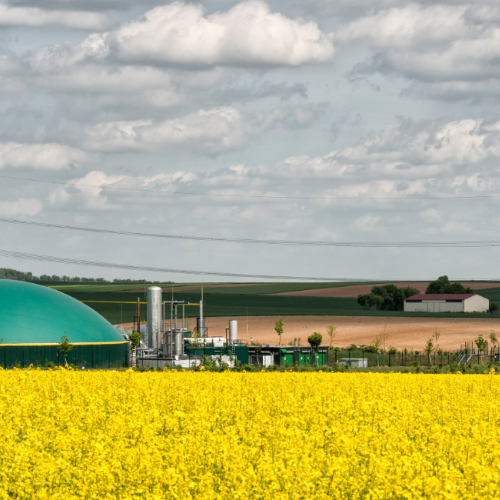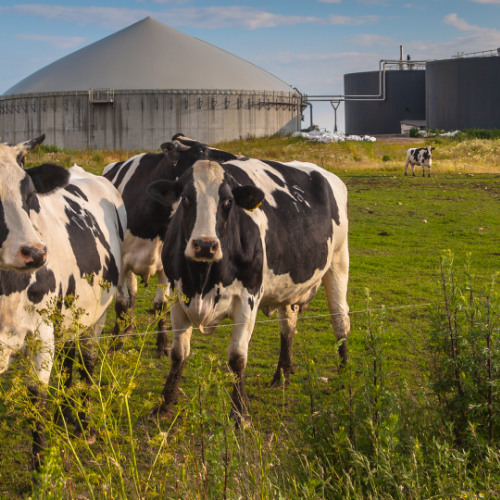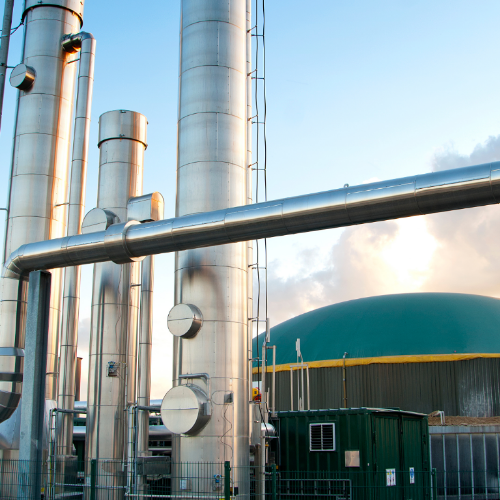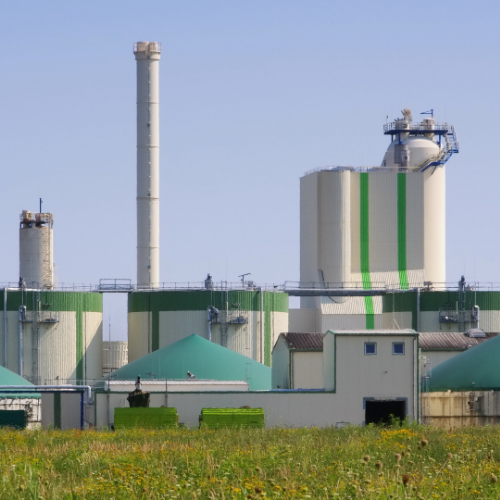BIOGAS
Read More
Making biogas is a practice that has been carried out for centuries, mostly in Asia. There is some anecdotal evidence that indicates that gas may have been burnt to heat bath water as early as the 10th century in Assyria, and later in Persia in the 16th century. It is believed that the first official biogas plant was built in a leper colony in Bombay (now Mumbai), India, around 1859.
Biogas is mostly made up of methane and carbon dioxide, but also has small amounts of impurities. If biogas has the carbon dioxide and impurities removed, then it can burn with a higher calorific value (it burns hotter).
Biogas can be burnt to provide heat (for cooking), or to power steam turbines (for generating electricity). It can also be compressed and used to generate mechanical power in engines. The use of biogas in vehicles is still experimental, as it currently requires more energy to compress the gas than can actually be harvested from the gas when it is burnt (which means it is not viable).
What are the processes involved in generating biogas?
There are basically 4 steps in the anerobic digestion of organic material. These are:
- Hydrolysis
- Acidogenesis
- Acetogenesis
- Methanogenesis
All four stages are carried out by anaerobic bacteria, meaning they survive in conditions where there is no oxygen.
A simplification of what happens over these four stages is:
- Anaerobic bacteria interact with glucose and sugars (from carbohydrates in wastes)
- The waste products of this processing by bacteria are carbon dioxide, water and methane, which is what is piped off
- The remaining solid material that the bacteria cannot digest (as well as any dead bacteria) are left behind in the solid waste (called digestate).
How does a biogas system work?
First, there is a large container of organic waste (generally including manure of some kind). This is fed in through a pipe that does not allow air to enter. The waste begins to decompose anaerobically and the products of the decomposition are methane, carbon dioxide and water. The gas is tapped out via pipes and fed to where it is being burned. There is an outlet pipe for the leftover digestate. This solid waste can still be used as fertilizer on plants and crops (provided that it is tested to be safe and that there are no heavy metals and hormones detected in it). The methane-producing bacteria are sensitive to pH and can only operate in conditions of a pH of about 6.5 to 8.
What are the advantages of biogas systems?
- Localized management of waste and production of useful energy for households and businesses (eg. for cooking, heating)
What are the disadvantages of biogas systems?
- Tricky to get the balance right in the system (waste quantities, volume of liquid and pH)
- Gas production may not be consistent or possible all year round – depends on amount of waste coming in and efficiency of the process.
How does using biogas help me to reduce my carbon footprint?
- It allows you to trap the methane that would be released from decomposing waste if it is left open to the atmosphere
- Reducing the amount of methane that is released directly in the atmosphere is significant, because unburnt methane is a very potent greenhouse gas. When we burn methane, the waste products are carbon dioxide and water, which are also greenhouse gases, but they are much less potent than methane itself (about 24 times less).
Important considerations before installing a biogas system project
- How much space do you have available for setting up the system?
- What are your budget constraints – this will affect what kind of equipment you can get
- What do you want to use the biogas for? Electricity generation or cooking?
- How large is the scale of your project – what are your energy needs
- What is the daily volume of solid waste generated on site – will you need to obtain more waste and top up your system in order to harvest enough gas?
Read Less




Biogas




Read More
Making biogas is a practice that has been carried out for centuries, mostly in Asia. There is some anecdotal evidence that indicates that gas may have been burnt to heat bath water as early as the 10th century in Assyria, and later in Persia in the 16th century. It is believed that the first official biogas plant was built in a leper colony in Bombay (now Mumbai), India, around 1859.
Biogas is mostly made up of methane and carbon dioxide, but also has small amounts of impurities. If biogas has the carbon dioxide and impurities removed, then it can burn with a higher calorific value (it burns hotter).
Biogas can be burnt to provide heat (for cooking), or to power steam turbines (for generating electricity). It can also be compressed and used to generate mechanical power in engines. The use of biogas in vehicles is still experimental, as it currently requires more energy to compress the gas than can actually be harvested from the gas when it is burnt (which means it is not viable).
What are the processes involved in generating biogas?
There are basically 4 steps in the anerobic digestion of organic material. These are:
- Hydrolysis
- Acidogenesis
- Acetogenesis
- Methanogenesis
All four stages are carried out by anaerobic bacteria, meaning they survive in conditions where there is no oxygen.
A simplification of what happens over these four stages is:
- Anaerobic bacteria interact with glucose and sugars (from carbohydrates in wastes)
- The waste products of this processing by bacteria are carbon dioxide, water and methane, which is what is piped off
- The remaining solid material that the bacteria cannot digest (as well as any dead bacteria) are left behind in the solid waste (called digestate).
How does a biogas system work?
First, there is a large container of organic waste (generally including manure of some kind). This is fed in through a pipe that does not allow air to enter. The waste begins to decompose anaerobically and the products of the decomposition are methane, carbon dioxide and water. The gas is tapped out via pipes and fed to where it is being burned. There is an outlet pipe for the leftover digestate. This solid waste can still be used as fertilizer on plants and crops (provided that it is tested to be safe and that there are no heavy metals and hormones detected in it). The methane-producing bacteria are sensitive to pH and can only operate in conditions of a pH of about 6.5 to 8.
What are the advantages of biogas systems?
- Localized management of waste and production of useful energy for households and businesses (eg. for cooking, heating)
What are the disadvantages of biogas systems?
- Tricky to get the balance right in the system (waste quantities, volume of liquid and pH)
- Gas production may not be consistent or possible all year round – depends on amount of waste coming in and efficiency of the process.
How does using biogas help me to reduce my carbon footprint?
- It allows you to trap the methane that would be released from decomposing waste if it is left open to the atmosphere
- Reducing the amount of methane that is released directly in the atmosphere is significant, because unburnt methane is a very potent greenhouse gas. When we burn methane, the waste products are carbon dioxide and water, which are also greenhouse gases, but they are much less potent than methane itself (about 24 times less).
Important considerations before installing a biogas system project
- How much space do you have available for setting up the system?
- What are your budget constraints – this will affect what kind of equipment you can get
- What do you want to use the biogas for? Electricity generation or cooking?
- How large is the scale of your project – what are your energy needs
- What is the daily volume of solid waste generated on site – will you need to obtain more waste and top up your system in order to harvest enough gas?
Read Less
Biogas
Read More
Making biogas is a practice that has been carried out for centuries, mostly in Asia. There is some anecdotal evidence that indicates that gas may have been burnt to heat bath water as early as the 10th century in Assyria, and later in Persia in the 16th century. It is believed that the first official biogas plant was built in a leper colony in Bombay (now Mumbai), India, around 1859.
Biogas is mostly made up of methane and carbon dioxide, but also has small amounts of impurities. If biogas has the carbon dioxide and impurities removed, then it can burn with a higher calorific value (it burns hotter).
Biogas can be burnt to provide heat (for cooking), or to power steam turbines (for generating electricity). It can also be compressed and used to generate mechanical power in engines. The use of biogas in vehicles is still experimental, as it currently requires more energy to compress the gas than can actually be harvested from the gas when it is burnt (which means it is not viable).
What are the processes involved in generating biogas?
There are basically 4 steps in the anerobic digestion of organic material. These are:
- Hydrolysis
- Acidogenesis
- Acetogenesis
- Methanogenesis
All four stages are carried out by anaerobic bacteria, meaning they survive in conditions where there is no oxygen.
A simplification of what happens over these four stages is:
- Anaerobic bacteria interact with glucose and sugars (from carbohydrates in wastes)
- The waste products of this processing by bacteria are carbon dioxide, water and methane, which is what is piped off
- The remaining solid material that the bacteria cannot digest (as well as any dead bacteria) are left behind in the solid waste (called digestate).
How does a biogas system work?
First, there is a large container of organic waste (generally including manure of some kind). This is fed in through a pipe that does not allow air to enter. The waste begins to decompose anaerobically and the products of the decomposition are methane, carbon dioxide and water. The gas is tapped out via pipes and fed to where it is being burned. There is an outlet pipe for the leftover digestate. This solid waste can still be used as fertilizer on plants and crops (provided that it is tested to be safe and that there are no heavy metals and hormones detected in it). The methane-producing bacteria are sensitive to pH and can only operate in conditions of a pH of about 6.5 to 8.
What are the advantages of biogas systems?
- Localized management of waste and production of useful energy for households and businesses (eg. for cooking, heating)
What are the disadvantages of biogas systems?
- Tricky to get the balance right in the system (waste quantities, volume of liquid and pH)
- Gas production may not be consistent or possible all year round – depends on amount of waste coming in and efficiency of the process.
How does using biogas help me to reduce my carbon footprint?
- It allows you to trap the methane that would be released from decomposing waste if it is left open to the atmosphere
- Reducing the amount of methane that is released directly in the atmosphere is significant, because unburnt methane is a very potent greenhouse gas. When we burn methane, the waste products are carbon dioxide and water, which are also greenhouse gases, but they are much less potent than methane itself (about 24 times less).
Important considerations before installing a biogas system project
- How much space do you have available for setting up the system?
- What are your budget constraints – this will affect what kind of equipment you can get
- What do you want to use the biogas for? Electricity generation or cooking?
- How large is the scale of your project – what are your energy needs
- What is the daily volume of solid waste generated on site – will you need to obtain more waste and top up your system in order to harvest enough gas?
Read Less







